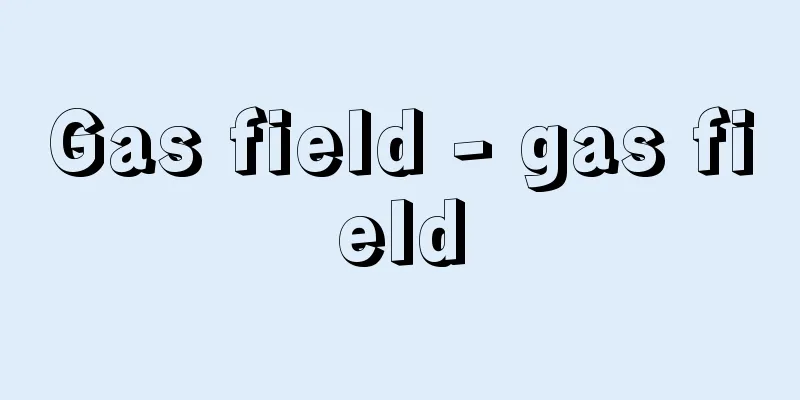Helicopter - Helicopter (English spelling)

|
A type of rotorcraft. Two or more long, thin wings (rotors) are arranged on one or more axes that are almost perpendicular to the longitudinal direction of the aircraft, and the engine rotates the wings to adjust the lift generated by the wings and tilt the surface of the rotor (plane of rotation or disk surface) to float in the air and obtain propulsion in the direction of flight. In addition to flying in the air like a normal airplane, it can also take off and land without a ground run, fly sideways to the left and right, fly backwards, and hover in the air. [Kazuo Ochiai] History and typesThe idea of rotorcraft flight is ancient, and can be seen in Leonardo da Vinci's sketches of a spiral rotorcraft from the late 15th century. However, for the next 400 years, many people tried to make it a reality, but they were unable to develop a light, powerful engine. In 1907, the French aviator Breguet created a multi-rotor helicopter with four rotors, which succeeded in a short, though unstable, flight. In 1920, the Spanish aviator Juan de la Cierva (1895-1936) discovered a unique phenomenon of rotorcraft in connection with the development of the autogyro, improved its structure, and the Spanish aviator Raoul Pescara invented a revolutionary method of simultaneous pitch control, which led to a remarkable improvement in rotorcraft performance. In 1935, Breguet applied these findings to create a coaxial rotor helicopter, which has two rotors on the same drive shaft, stacked one above the other and rotated in opposite directions. In 1937, Heinrich Focke of Germany created a parallel rotor helicopter with rotors rotating in opposite directions on the left and right sides of the aircraft, and both of them successfully flew full-scale, albeit for a short time. In 1940, in the United States, Sikorsky created a single rotor helicopter with one main rotor and one tail rotor to control the aircraft's direction and attitude, Frank Piasecki (1891-1972) created a tandem rotor helicopter with two rotors rotating in opposite directions on the front and rear of the aircraft, and Charles Kaman created a cross rotor helicopter with parallel rotors spaced very closely together and rotating crosswise, which formed the basis of modern helicopters. Helicopters first came into full use between the latter half of World War II and the Korean War in 1950. During this time, Sikorsky developed a revolutionary design in which the engine was placed in the nose and the rotor was driven by a shaft that was angled upwards, making it possible to create a large space for carrying personnel and supplies near the center of gravity. Furthermore, the practical application of lightweight, compact, and high-power turbine engines greatly improved helicopter performance, and aircraft suitable for uses such as passenger transport for 20 to 30 people and lifting heavy loads were developed. Furthermore, helicopter types were narrowed down based on track record in terms of mechanism, weight, and performance, and currently the three most common types are single rotor, tandem rotor, and coaxial rotor. [Kazuo Ochiai] principleThe wings rotate around a rotating shaft that is almost perpendicular to the longitudinal axis of the aircraft, and the attachment angle (pitch angle) of each rotor is simultaneously adjusted (simultaneous pitch control) to increase or decrease the lift of the rotors, thereby allowing the aircraft to ascend, descend, and hover in the air. In addition, the pitch of the rotors is periodically changed within the rotational plane (pitch periodic control) to tilt the disk surface drawn by the rotors and allow the aircraft to move in the direction desired by the pilot. However, in reality, when the rotors rotate while the aircraft moves forward, the rotors are subjected to asymmetric relative winds, causing the aircraft to oscillate, and the wings themselves are also subjected to strong centrifugal forces, which creates many technical problems. For this reason, the rotors are equipped with flapping hinges and dragging hinges to prevent the aircraft from oscillating or vibrating. In addition, the rotors require feathering hinges to change the pitch for control purposes. Rotors with these three hinges are called fully articulated, those with both a flapping hinge and a feathering hinge are called semi-articulated, and those with only a feathering hinge are called rigid. Most large aircraft are fully articulated. Semi-articulated rotors with two rotors that move up and down alternately are called seesaw rotors and are used on small aircraft. Rigid rotors are the oldest type, but were not used because they caused a lot of oscillation and vibration, but advances in materials and design have solved these problems, and they are now mainly used on small aircraft, contributing to improving maximum speed. [Kazuo Ochiai] PerformanceWhen a helicopter's forward speed increases, the relative wind speed of the forward rotor on the disk surface increases, but the retreating rotor decreases. Therefore, the pitch of the retreating rotor must be increased. However, if the pitch angle exceeds the limit, the helicopter will stall. The relative wind speed of the forward rotor, especially at the tip of the rotor, is very high, and it may approach the speed of sound, generating shock waves that reduce efficiency, increase resistance, and cause a stall. In reality, however, the retreating rotor usually stalls earlier. In any case, for these reasons, the forward speed of a helicopter is limited to about 400 kilometers per hour. The payload was originally about 30% of the total weight, but with the adoption of turbine engines, it has now increased to about 50%. In addition, compared to fixed-wing aircraft, helicopters generally have disadvantages such as a complex structure, a lot of vibration, difficulty in control, and a high aircraft price. However, technological advances in design and manufacturing, the development of new aircraft materials, automatic stabilization and autopilot systems, and the improvement of navigation equipment for all-weather flight are rapidly improving. [Kazuo Ochiai] ApplicationsCivilian helicopters are mainly used for aerial surveying, photography, transporting personnel and supplies, firefighting and rescue, press and publicity, and liaison and surveillance, but in Japan they are also used for spraying chemicals in limited areas such as small farmland and forests, and their results have attracted attention from other countries. Regular passenger transport is also carried out in some areas, and it is profitable for a limited period of time. In military use, helicopters are used for command and liaison, reconnaissance, transporting weapons and troops, rescue activities, and searching for and attacking enemy submarines when equipped with special equipment and weapons. Ground attack helicopters, equipped with radar and powerful weapons and with fuselages as thin as possible to avoid being hit, are indispensable weapons in local warfare due to their agile maneuverability. In Japan, due to its small land area and complex terrain, a considerable number of helicopters are used for civilian purposes, but military helicopters account for the majority of helicopters in use worldwide. [Kazuo Ochiai] futureCompared to fixed-wing aircraft, helicopters have the advantage of being able to take off and land vertically, hover in mid-air, and fly left and right and backwards, but are still inferior in maximum speed, ceiling, and range. To make up for this shortcoming, prototypes of compound helicopters equipped with small fixed wings for cruising and auxiliary propulsion units have been created, achieving speeds of 500 kilometers per hour. Aiming for even higher speeds, a system is also being considered in which the rotors are folded or stored during cruising. Although helicopters take off and land vertically without a runway, they obtain propulsion by tilting the rotor disks, so they are not considered to be VTOL (V-to-L) aircraft. [Kazuo Ochiai] [References] | | |©Toshihisa Watanabe "> Helicopter structure (twin turbine engine) ©Shogakukan "> Principles of helicopter flight ©Shogakukan "> Rotor articulation and steering mechanism Air Self-Defense Force rescue helicopter. Overall length 19.8m, main rotor diameter 16.4m, maximum speed approximately 265km/h. Crew: 5 people ©Shogakukan "> Rescue helicopter UH-60J A patrol helicopter of the Japan Maritime Self-Defense Force. Overall length 19.8m, rotor diameter 16.4m, maximum speed approximately 257km/h ©Shogakukan "> Patrol helicopter SH-60K A combat helicopter of the Japan Ground Self-Defense Force. Overall length 17.73m, main rotor diameter 14.63m, maximum weight 10.4t, maximum speed 270km/h, crew of 2. Air-to-air missiles, 70mm rockets, Hellfire missiles, 30mm cannon ©Shogakukan "> Combat helicopter AH-64D A transport helicopter of the Japan Ground Self-Defense Force. Overall length 30.18m, main rotor diameter 18.29m, maximum gross weight 22.68t, maximum speed 280km/h. Crew 3 + 55 persons ©Shogakukan "> Transport helicopter CH-47J Source: Shogakukan Encyclopedia Nipponica About Encyclopedia Nipponica Information | Legend |
|
回転翼航空機の一種。機体の前後方向に対してほぼ垂直な1本または複数の軸に、2枚またはそれ以上の細長い翼(回転翼、ローターrotor)を配置し、エンジンによってこの翼を回転させ、翼に発生する揚力を加減したり、回転翼が描く面(回転面または円板面)を傾けることにより、空中に浮かんだり飛行方向への推進力を得る。普通の飛行機と同じように空中を飛行するほか、地上滑走なしに離着陸したり、左右への横ばい飛行や後退飛行、空中停止(ホバーリングhovering)などを行うことができる。 [落合一夫] 歴史と型式回転翼による飛行の構想は古く、15世紀末のレオナルド・ダ・ビンチの螺旋(らせん)面回転翼機のスケッチにそれを見ることができる。しかし、その後の400年ほどの間は、多くの人々に試みられながら、軽くて高出力のエンジンが得られずに実現しなかった。1907年、フランスのブレゲーが4個の回転翼をもつマルチローター方式のヘリコプターをつくり、不安定ではあったがごく短時間の浮揚に成功した。1920年にはスペインのド・ラ・シェルバJuan de la Cierva(1895―1936)がオートジャイロの開発に関連して回転翼の独特な現象を発見、その構造を改良し、さらにスペインのペスカラRaoul Pescaraが画期的な同時ピッチ制御を発明した結果、回転翼の性能は著しく進歩した。1935年、ブレゲーはこれらの成果を導入して、同一駆動軸上の2個の回転翼を上下に重ねて配置し、互いに逆方向に回転させる同軸反転式回転翼ヘリコプターを製作した。1937年にはドイツのフォッケHeinrich Fockeが、機体の左右に互いに逆方向に回転する回転翼を配置した並列回転翼式ヘリコプターをつくり、どちらも短時間ではあったが本格的な飛行に成功した。1940年、アメリカでシコルスキーが1個の主回転翼と機体の方向や姿勢を制御する1個の尾部回転翼をもつ単回転翼式ヘリコプターを、パイアセッキFrank Piasecki(1891―1972)が互いに逆方向に回転する2個の回転翼を機体の前後に配置したタンデム回転翼式ヘリコプターを、またカマンCharles Kamanは並列する回転翼の間隔をきわめて狭くして互いに交差回転させる交差反転式ヘリコプターを完成し、現在のヘリコプターの基礎ができあがった。 ヘリコプターが本格的に実用化されたのは第二次世界大戦後期から1950年の朝鮮戦争にかけてである。この時期に、シコルスキー社が機首にエンジンを配置し、斜め上方に軸を通して回転翼を駆動するという画期的な型式を開発し、重心位置付近に人員・物資を搭載する広い空間を設けることができるようになった。さらに軽量・小型で高出力のタービンエンジンの実用化によってヘリコプターの性能は大幅に向上し、20~30人乗りの旅客輸送や、重量物の吊(つ)り上げ専用など用途に適した機体もつくられるようになった。また、ヘリコプターの型式も機構、重量、性能などの面から実績に基づいて絞られ、現在は単回転翼式、タンデム回転翼式、同軸回転翼式の三つが主流となっている。 [落合一夫] 原理機体の前後軸にほぼ垂直な回転軸の周りに翼を回転させ、各回転翼の取り付け角(ピッチ角)を同時に加減し(同時ピッチ制御)、回転翼の揚力を増減させることによって上昇、下降、空中停止を行う。また、回転翼のピッチを回転面内で周期的に変化させる(ピッチ周期制御)ことによって、回転翼の描く円板面を傾け、操縦士の思う方向に進ませる。しかし実際には回転翼が回転しながら機体が進むと、回転翼は非対称の相対風を受けることになって、機体が動揺し、翼自体もまた強い遠心力を受けながらピッチを変えなければならないなど、技術的な問題が多い。そのため、回転翼にフラッピングヒンジflapping hingeとドラッギングヒンジdragging hingeを設けて機体の動揺や振動を防いでいる。回転翼にはこのほかに操縦用として、ピッチを変えるフェザーリングヒンジfeathering hingeが必要である。この三つのヒンジをもつ型式の回転翼を全関節式、フラッピングヒンジとフェザーリングヒンジの二つをもつものを半関節式、フェザーリングヒンジだけのものをリジッド型という。大型機はほとんど全関節型である。半関節型のうち2枚の回転翼が交互に上下するものをシーソー回転翼といい、小型機に用いられている。リジッド型の回転翼はもっとも古い型式であるが、動揺・振動が多いので用いられなかったが、材料や設計の進歩で問題点が解決し、現在は主として小型機に採用され、最大速度の向上に貢献している。 [落合一夫] 性能ヘリコプターの前進速度が速くなると、円板面の前進側の回転翼の相対風速が大きくなるが、後退側回転翼では小さくなる。したがって、後退側回転翼のピッチを大きくする必要がある。しかし、ピッチ角が限界を超えれば失速をおこす。前進側の回転翼は、ことに翼端部で相対風速が非常に大きくなり、音速に近づいて衝撃波を発生して効率の低下、抵抗の増大、失速などを生じることも考えられるが、実際には後退側回転翼の失速のほうが早くおこるのが普通である。どちらにしてもこのような理由で、ヘリコプターの前進速度は時速400キロメートル程度が限界とされている。搭載量は、当初は総重量の30%程度であったが、タービンエンジンの採用によって現在では50%程度にまで増大している。そのほかは一般に固定翼機に比べると、構造が複雑で振動が多く、操縦がむずかしい、機体価格が高いなどの欠点がある。しかし、設計と製作の技術的進歩、新しい機体材料の開発、自動安定・自動操縦装置、全天候飛行用の航法装備の充実などによって、急速に改善されつつある。 [落合一夫] 用途民間用としては、空中測量、写真撮影、人員・物資輸送、消火救難、報道宣伝、連絡監視などの作業が主体であるが、日本では狭い農地や森林など限定された地域への薬剤散布作業にも使われ、その成果が諸外国から注目されている。定期旅客輸送も一部で行われ、限定された期間ならば採算がとれるようになっている。軍用では、指揮連絡、偵察、武器・兵員輸送、救難活動のほか、特殊装備と武装を施して敵潜水艦の捜索・攻撃に用いられ、また、レーダーや強力な武器を搭載し、被弾を避けるために胴体を極力細くした地上攻撃用ヘリコプターは、機敏な機動力によって局地戦に欠くことのできない兵器となっている。日本では国土が狭いうえ、複雑な地形をもつ関係で、民間用としてかなりのヘリコプターが使われているが、世界的には軍用ヘリコプターが使用機数の大半を占めている。 [落合一夫] 将来固定翼機に比べて、垂直離着陸、空中停止、左右および後退飛行ができる利点があるが、最大速度、上昇限度、航続距離でまだ劣っている。そこで、この欠点を補うため巡航用の小型固定翼や補助推進装置を取り付けた複合ヘリコプターが試作されており、時速500キロメートルを実現している。さらに高速を目ざし、巡航中は回転翼を折り畳んだり収納してしまう方式も考えられている。なお、ヘリコプターは滑走距離なしで垂直に離着陸するが、回転翼円板を傾けることによって推進力を得るので、VTOL(ブイトール)機には属さないことになっている。 [落合一夫] [参照項目] | | |©渡部利久"> ヘリコプターの構造(タービン双発機) ©Shogakukan"> ヘリコプターの飛行の原理 ©Shogakukan"> ローターの関節と操縦機構 航空自衛隊の救難ヘリコプター。全長19.8m、主回転翼直径16.4m、最大速度約265km/h。乗員5名©Shogakukan"> 救難ヘリコプターUH-60J 海上自衛隊の哨戒ヘリコプター。全長19.8m、回転翼直径16.4m、最大速度約257km/h©Shogakukan"> 哨戒ヘリコプターSH-60K 陸上自衛隊の戦闘ヘリコプター。全長17.73m、主回転翼直径14.63m、最大全備重量10.4t、最大速度270km/h、乗員2名。空対空ミサイル、70mmロケット弾、ヘルファイアミサイル、30mm機関砲©Shogakukan"> 戦闘ヘリコプターAH-64D 陸上自衛隊の輸送ヘリコプター。全長30.18m、主回転翼直径18.29m、最大全備重量22.68t、最高速度280km/h。乗員3+55名©Shogakukan"> 輸送ヘリコプターCH-47J 出典 小学館 日本大百科全書(ニッポニカ)日本大百科全書(ニッポニカ)について 情報 | 凡例 |
Recommend
Rayleigh-Jeans' law of radiation
This is one of the formulas that gives the energy ...
Chemical Reagents
...A general term for chemicals for testing and r...
Nahapāna (English spelling)
…The two most powerful Kshatrapa powers were (1) ...
Companion of Sirius
Its official name is Sirius B. Its luminosity is 8...
llanero
...the cowboys of the Pampas, which straddle Arge...
Kansai Gomen - Kansan Gomen
…In 1949, the current Marubeni Corporation was es...
Wooden stupa - Kyogitoba
...Mochizuki Nobuyuki's "Encyclopedia of...
Wakebe-shi - Wakebe-ji
A feudal lord of the early modern period. Born in ...
Heijo-kyo
Nara was the capital of Japan for about 70 years ...
Ground squirrel
A type of terrestrial squirrel that lives in burro...
positive transparency
…diapositive (positive transparency) is a photogr...
Otone [town] - Otone
An old town in Kitasaitama District, northeastern ...
Sukhavativyuha (English spelling)
…One of the Mahayana Buddhist scriptures that pre...
Closed fishing season
A period during which the capture and collection o...
Istro-Romanian - Istro-Romanian
…(3) Megleno-Romanian: Approximately 10,000 speak...

![Kanzaki [town] - Kanzaki](/upload/images/67cb48f792b17.webp)







